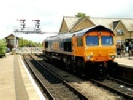Archive Section




A Lecture by Peter Rooke of the West Cumberland Railway Museum
Tuesday 4th February 2020, Palestra House
Written by John Doyle
Peter Rooke travelled from Cumbria to deliver his talk to members assembled in one of Palestra House's many meeting rooms. Peter is a now retired civil engineer who worked for many years at the Sellafield nuclear installation. His energies are now channelled towards establishment and maintenance of the West Cumberland Railway museum in the coastal village of St Bees where his numerous railway artefacts are housed.
The museum is located in what was St Bees "department store" on Main Street. Entrance is free, voluntary donations towards it's upkeep and the acquisition of further exhibits are welcome and generally acknowledged by a large slice of cake. Details of the museum can be found at the Facebook page "West Cumberland Railway Museum".
Peter described how the railways of Cumbria arrived early in the 19th century to serve the needs of industry particularly coal and iron rather than those of passengers. Cumbria's earliest railway was the east west Newcastle and Carlisle followed by those from Carlisle to Maryport, and Port Carlisle. Both Enterprises were driven by the desire to link coal extraction with west coast seaports. The coming of the railways as well as promoting economic growth was also an engine of social change in Cumbria.
Peter told of George Stephenson's eminent role in promoting and constructing early Cumbrian railways. He was instrumental in advocating a more heavily engineered version of the now Cumbrian coast line as the link between Lancaster an Carlisle. The proposal was rejected by a Parliamentary commission in favour of the present route via Shap summit. Peter also related how Stephenson's "Rocket" found its way to preservation after a brief, unsuccessful second career, working coal trains in the Brampton coal field.
The early Cumbrian railways were incredibly profitable on the back of mineral and goods traffic some paying dividends as high as 20% which seem astronomical compared to today's bank interest rates on savings. Peter continued the story of how the local companies were amalgamated, nationalised and eventually how many lines closed as the industries they supported closed. He highlighted the once major steel works in Workington which manufactured rail, not only for Britain, but also much of the World.
Peter spoke about a number of local curiosities: Coppernob an 1846 Furness Railway locomotive displayed for many years in a glass enclosure at Barrow in Furness until being directly hit by a bomb during the last World War. The loco can now be seen at the National Railway museum, shrapnel scars and all. A very early locomotive works established at Lowca on the coast which lasted until 1926, it's business fatally undermined by a disasterous fire in which the wooden patterns used during manufacture were burned. The last standard gauge rope worked incline the Corkickle Brake which survived as late as 1986, handling 1/2 million tons of traffic at its peak.
To bring things up to date Peter spoke about loco haulage on the Cumbria coast and described a proposal now underway to deep mine high quality coal from a pit near Whitehaven to be transported by rail to Teesside and then export for steel making.
Peter brought several interesting artefacts from the museum which the audience were invited to view and handle during the talk. Of particular interest was a time piece, still in working order, used to "transport" railway time around the country before the widespread use of the electric telegraph. When it's use was superceded by the telegraph it was presented as a long service award to a guard, and has hence survived . It is incredibly rare and is said to be one of only three surviving in the world.
The talk was greatly appreciated by the audience who asked several questions before the evening concluded with Peter being thanked in the usual way.